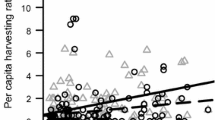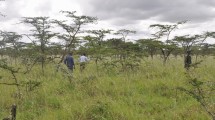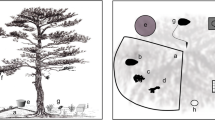Abstract
Integrative studies of plant–animal interactions that incorporate the multiple effects of interactions are important for discerning the importance of each factor within the population dynamics of a plant species. The low regeneration capacity of many Acacia species in arid savannas is a consequence of a combination of reduction in seed dispersal and high seed predation. Here we studied how ungulates (acting as both seed dispersers and herbivores) and bruchid beetles (post-dispersal seed predators) modulate the population dynamics of A. raddiana, a keystone species in the Middle East. We developed two simulation models of plant demography: the first included seed ingestion by ungulates and seed predation by bruchids, whereas the second model additionally incorporated herbivory by ungulates. We also included the interacting effects of seed removal and body mass, because larger ungulates destroy proportionally fewer seeds and enhance seed germination. Simulations showed that the negative effect of seed predation on acacia population size was compensated for by the positive effect of seed ingestion at 50 and 30% seed removal under scenarios with and without herbivory, respectively. Smaller ungulates (e.g., <35 kg) must necessarily remove tenfold more seeds than larger ungulates (e.g., >250 kg) to compensate for the negative effect of seed predation. Seedling proportion increased with seed removal in the model with herbivory. Managing and restoring acacia seed dispersers is key to conserving acacia populations, because low-to-medium seed removal could quickly restore their regeneration capacity.



Similar content being viewed by others
References
Andersen GL, Krzywinski K (2007) Mortality, recruitment and change of desert tree populations in a hyper-arid environment. PLoS ONE 2:e208
Ashkenazi S (1995) Acacia trees in the Negev and the Arava, Israel. Israel Land Development Authority, Jerusalem
Bodmer R, Ward D (2006) Frugivory in large mammalian herbivores. In: Danell K, Bergström R, Duncan P, Pastor J (eds) Large herbivore ecology, ecosystem dynamics and conservation. Cambridge University Press, Cambridge, pp 232–260
Bond WJ, Loffell D (2001) Introduction of giraffe changes Acacia distribution in a South African savanna. Afr J Ecol 39:286–294
Bravo SP (2008) Seed dispersal and ingestion of insect-infested seeds by black howler monkeys in flooded forests of the Parana River, Argentina. Biotropica 40:471–476
Brodie JF, Helmy OE, Brockelman WY, Maron JL (2009) Functional differences within a guild of tropical mammalian frugivores. Ecology 90:688–698
Bronstein JL (2001) The costs of mutualism. Am Zool 41:825–839
Clark JS, Beckage B, Camill P, Cleveland B, HilleRisLamber J, Lichter J, McLachlan J, Mohan J, Wyckoff P (1999) Interpreting recruitment limitation in forest. Am J Bot 86:1–16
Clauss M, Schwarm A, Ortmann S, Streich WJ, Hummel J (2007) A case of non-scaling in mammalian physiology? Body size, digestive capacity, food intake, and ingesta passage in mammalian herbivores. Comp Biochem Phys A 148:249–265
Coe M, Coe C (1987) Large herbivores, Acacia trees and bruchid beetles. S Afr J Sci 83:624–635
Cordeiro NJ, Howe HF (2001) Low recruitment of trees dispersed by animals in African forest fragments. Conser Biol 15:1733–1741
Cowling RM, Richardson DM, Pierce SM (1997) Vegetation of southern Africa. Cambridge University Press, Cambridge
Donatti CI, Guimaraes PR, Galetti M (2009) Seed dispersal and predation in the endemic Atlantic rainforest palm Astrocaryum aculeatissimum across a gradient of seed disperser abundance. Ecol Res 24:1187–1195
Du Toit JT, Bryant JP, Frisby K (1990) Regrowth and palatability of Acacia shoots following pruning by African savanna browsers. Ecology 71:149–154
Duncan AJ, Poppi DP (2008) Nutritional ecology of grazing and browsing ruminants. In: Gordon IJ, Prins HHT (eds) The ecology of browsing and grazing. Springer, Berlin, pp 89–112
Ehrlén J (2002) Assessing the lifetime consequences of plant–animal interactions for the perennial herb Lathyrus vernus (Fabaceae). Perspect Plant Ecol 5:145–163
Evenari M, Shanan L, Tadmor N (1982) The Negev. The challenge of a desert. Harvard University Press, Cambridge
Fornara DA, Du Toit JT (2008a) Community-level interactions between ungulate browsers and woody plants in an African savanna dominated by palatable-spinescent Acacia trees. J Arid Environ 72:534–545
Fornara DA, Du Toit JT (2008b) Responses of woody saplings exposed to chronic mammalian herbivory in an African savanna. Ecoscience 15:129–135
Fragoso JMV, Silvius KM, Correa JA (2003) Long-distance seed dispersal by tapirs increases seed survival and aggregates tropical trees. Ecology 84:1998–2006
Godínez-Álvarez H, Jordano P (2007) An empiricial approach to analysing the demographic consequences of seed dispersal by frugivores. In: Dennis AJ, Schupp EW, Green R, Westcott DA (eds) Seed dispersal: theory and its application in a changing world. CAB International, Wallingford, pp 391–406
Goheen JR, Young TP, Keesing F, Palmer TM (2007) Consequences of herbivory by native ungulates for the reproduction of a savanna tree. J Ecol 95:129–138
Hakham E, Ritte U (1993) Foraging pressure of the Nubian ibex Capra ibex nubiana and its effect on the indigenous vegetation of the Ein Gedi Nature Reserve, Israel. Biol Conserv 63:9–21
Halevy G (1974) Effects of gazelles and seed beetles (Bruchidae) on germination and establishment of acacia species. Israel J Bot 23:120–126
Hauser TP (1994) Germination, predation and dispersal of Acacia albida seeds. Oikos 70:421–426
Herrera CM, Pellmyr O (2002) Plant–animal interactions: an evolutionary approach. Blackwell, Oxford
Howe HF, Miriti MN (2004) When seed dispersal matters. Bioscience 54:651–660
Lamprey HF, Halevy G, Makacha S (1974) Interactions between Acacia, bruchid seed beetles and large herbivores. Afr J Ecol 12:81–85
Miller MF (1994) Large African herbivores, bruchid beetles and their interactions with acacia seeds. Oecologia 97:265–270
Miller MF (1995) Acacia seed survival, seed germination and seedling growth following pod consumption by large herbivores and seed chewing by rodents. Afr J Ecol 33:194–210
Munzbergova Z, Ward D (2002) Acacia trees as keystone species in Negev desert ecosystems. J Veg Sci 13:227–236
Oba G (1998) Effects of excluding goat herbivory on Acacia tortilis woodland around pastoralist settlements in northwest Kenya. Acta Oecol 19:395–404
Or K, Ward D (2003) Three-way interactions between Acacia, large mammalian herbivores and bruchid beetles—a review. Afr J Ecol 41:257–265
Owen-Smith N (1988) Megaherbivores. The influence of very large body size on ecology. Cambridge University Press, Cambridge
Owen-Smith N (2007) The comparative population dynamics of browsing and grazing ungulates. In: Gordon IJ, Prins HHT (eds) The ecology of browsing and grazing. Springer, Berlin, pp 149–177
Peres CA (2000) Effects of subsistence hunting on vertebrate community structure in amazonian forests. Conserv Biol 14:240–253
Peres CA, Palacios E (2007) Basin-wide effects of game harvest on vertebrate population densities in amazonian forests: implications for animal-mediated seed dispersal. Biotropica 39:304–315
Reid RS, Ellis JE (1995) Impacts of pastoralists on woodlands in south Turkana, Kenya: livestock-mediated tree recruitment. Ecol Appl 5:978–992
Rios RS, Pacheco LF (2006) The effect of dung and dispersal on postdispersal seed predation of Attalea phalerata (Arecaceae) by bruchid beetles. Biotropica 38:778–781
Rohner C, Ward D (1997) Chemical and mechanical defense against herbivory in two sympatric species of desert Acacia. J Veg Sci 8:717–726
Rohner C, Ward D (1999) Large mammalian herbivores and the conservation of arid Acacia stands in the Middle East. Conserv Biol 13:1162–1171
Rooke T, Bergstrom R, Skarpe C, Danell K (2004) Morphological responses of woody species to simulated twig-browsing in Botswana. J Trop Ecol 20:281–289
Saltz D, Rubenstein DI (1995) Population dynamics of a reintroduced asiatic wild ass (Equus hemionus) Herd. Ecol Appl 5:327–335
Saltz D, Rowen M, Rubenstein DI (2000) The effect of space-use patterns of reintroduced Asiatic wild ass on effective population size. Conserv Biol 14:1852–1861
Schupp EW, Jordano P, Gómez JMa (2010) Seed dispersal effectiveness revisited: a conceptual review. New Phytol 188:333–353
Shkedy Y, Saltz D (2000) Characterizing core and corridor use by Nubian ibex in the Negev desert, Israel. Conserv Biol 14:200–206
Silva M, Brimacombe M, Downing JA (2001) Effects of body mass, climate, geography, and census area on population density of terrestrial mammals. Global Ecol Biogeogr 10:469–485
Silvius KM, Fragoso JMV (2002) Pulp handling by vertebrate seed dispersers increases palm seed predation by bruchid beetles in the northern Amazon. J Ecol 90:1024–1032
Smit N (1999) Guide to acacias of South Africa. Briza, Pretoria
Vander Wall SB, Longland WS (2004) Diplochory: are two seed dispersers better than one? Trends Ecol Evol 19:155–161
Wang BC, Smith TB (2002) Closing the seed dispersal loop. Trends Ecol Evol 17:379–386
Ward D (2009) The biology of deserts. Oxford University Press, Oxford
Ward D (2010) The effects of apical meristem damage on growth and defenses of two Acacia species in the Negev desert. Evol Ecol Res 12:589–602
Ward D, Rohner C (1997) Anthropogenic causes of high mortality and low recruitment in three Acacia tree taxa in the Negev desert, Israel. Biodivers Conserv 6:877–893
Wiegand K, Jeltsch F, Ward D (1999) Analysis of the population dynamics of Acacia trees in the Negev desert, Israel with a spatially-explicit computer simulation model. Ecol Model 117:203–224
Wiegand K, Jeltsch F, Ward D (2000a) Do spatial effects play a role in the spatial distribution of desert-dwelling Acacia raddiana? J Veg Sci 11:473–484
Wiegand K, Ward D, Thulke HH, Jeltsch F (2000b) From snapshot information to long-term population dynamics of acacias by a simulation model. Plant Ecol 150:97–114
Wiegand K, Jeltsch F, Ward D (2004) Minimum recruitment frequency in plants with episodic recruitment. Oecologia 141:363–372
Wills C, Condit R, Foster RB, Hubbell SP (1997) Strong density- and diversity-related effects help to maintain tree species diversity in a neotropical forest. Proc Natl Acad Sci USA 94:1252–1257
Wright SJ, Stoner KE, Beckman N, Corlett RT, Dirzo R, Muller-Landau HC, Nunez-Iturri G, Peres CA, Wang BC (2007) The plight of large animals in tropical forests and the consequences for plant regeneration. Biotropica 39:289–291
Acknowledgments
We are grateful to Christoph Rohner for helping to develop the early idea for the present project, and to Luis Santamaría and two anonymous referees for their useful comments that greatly improved the early version of the manuscript. The work was supported by the Friedrich-Schiller University of Jena (Germany) and by the JEN-A-MACE project (Jena Initiative of Applying Molecular Techniques for the Analysis of Variations of Ecological Processes in Space), funded by the EU (ToK initiative).
Author information
Authors and Affiliations
Corresponding author
Additional information
Communicated by John Silander.
Electronic supplementary material
Below are the links to the electronic supplementary material.
Rights and permissions
About this article
Cite this article
Rodríguez-Pérez, J., Wiegand, K. & Ward, D. Interaction between ungulates and bruchid beetles and its effect on Acacia trees: modeling the costs and benefits of seed dispersal to plant demography. Oecologia 167, 97–105 (2011). https://doi.org/10.1007/s00442-011-1964-6
Received:
Accepted:
Published:
Issue Date:
DOI: https://doi.org/10.1007/s00442-011-1964-6




